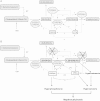Medullary nephrocalcinosis in an adult patient with idiopathic infantile hypercalcaemia and a novel CYP24A1 mutation
- PMID: 24175086
- PMCID: PMC3811979
- DOI: 10.1093/ckj/sft008
Medullary nephrocalcinosis in an adult patient with idiopathic infantile hypercalcaemia and a novel CYP24A1 mutation
Erratum in
-
Erratum: Medullary nephrocalcinosis in an adult patient with idiopathic infantile hypercalcaemia and a novel CYP24A1 mutation.Clin Kidney J. 2013 Aug;6(4):453. doi: 10.1093/ckj/sft091. Clin Kidney J. 2013. PMID: 27293582 Free PMC article.
Abstract
Idiopathic infantile hypercalcaemia (IIH) is an autosomal recessively inherited disease, presented in the first year of life with hypercalcaemia, precipitated by normal amounts of vitamin D supplementation. Recently loss-of-function mutations in the CYP24A1 gene, which encodes the vitamin D-metabolizing enzyme 24-hydroxylase, have been found in these patients. We describe a young man homozygous for a novel missense mutation (c.628T>C) of the CYP24A1 gene. He had suffered from severe hypercalcaemia in early childhood. At age 29 he presented with medullary nephrocalcinosis, chronic kidney disease (CKD) stage 2, microalbuminuria, mild hypertension and nephrogenic diabetes insipidus. He had mild hypercalcaemia and moderate hypercalciuria. As a novel finding, fibroblast growth factor 23 (FGF23) was elevated.
Keywords: fibroblast growth factor 23; hypercalcaemia; nephrocalcinosis.
Figures




References
-
- Jones G, Prosser DE, Kaufmann M. 25-Hydroxyvitamin D-24-hydroxylase (CYP24A1): its important role in the degradation of vitamin D. Arch Biochem Biophys. 2012;523:9–18. doi:10.1016/j.abb.2011.11.003. - DOI - PubMed
-
- Wang TJ, Zhang F, Richards JB, et al. Common genetic determinants of vitamin D insufficiency: a genome-wide association study. Lancet. 2010;376:180–188. doi:10.1016/S0140-6736(10)60588-0. - DOI - PMC - PubMed
-
- Ahn J, Yu K, Stolzenberg-Solomon R, et al. Genome-wide association study of circulating vitamin D levels. Hum Mol Genet. 2010;19:2739–2745. doi:10.1093/hmg/ddq155. - DOI - PMC - PubMed
-
- St-Arnaud R. Targeted inactivation of vitamin D hydroxylases in mice. Bone. 1999;25:127–129. doi:10.1016/S8756-3282(99)00118-0. - DOI - PubMed
-
- Masuda S, Byford V, Arabian A, et al. Altered pharmacokinetics of 1alpha,25-dihydroxyvitamin D3 and 25-hydroxyvitamin D3 in the blood and tissues of the 25-hydroxyvitamin D-24-hydroxylase (Cyp24a1) null mouse. Endocrinology. 2005;146:825–834. doi:10.1210/en.2004-1116. - DOI - PubMed
LinkOut - more resources
Full Text Sources
Other Literature Sources
Research Materials

